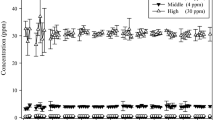Abstract
To clarify the acute and subchronic inhalation toxicity of tetraethoxysilane [TEOS, Si(OC2H5)4], groups of ten male ICR mice (SPF grade) were exposed to 1000 ppm TEOS for 1, 2, 4 or 8 h (acute inhalation study), or to 200 ppm of TEOS for 6 h/day, 5 days/week, for 2 or 4 weeks (subchronic inhalation study). The numbers of mice that died during 2 weeks of observation were 0, 1, 1 and 6 in the 1-, 2-, 4- and 8-h inhalation experiments and zero in the subchronic inhalation study. In the acute inhalation study, body weight decreased after TEOS exposure and did not reach the level of control mice during 2 weeks of observation except in the 1-h inhalation study. In the subchronic exposure study, weight gain was suppressed during the exposure period. Body weight in mice exposed for 2 weeks reached the level of non-exposed mice during the 2-week observation period, but did not do so in mice exposed for 4 weeks. Acute tubular necrosis (ATN) and acute splenic atrophy (ASA) were observed in all dead mice in the acute inhalation study, and tubulointerstitial nephritis (TIN) was frequently found in the surviving mice in both the acute and subchronic studies. However, blood biochemical examinations revealed no evidence of renal dysfunction. The olfactory epithelium was necrotic in all dead mice. In the subchronic inhalation study, infiltration of polymorphonuclear neutrophils in the nasal mucosa was observed in all mice killed 1 day after exposure. These results indicate that the LCL0 for 1-h exposure to TEOS and LC50 for 4-h exposure are greater than 1000 ppm, and that the kidney and nasal mucosa are the target organs for TEOS inhalation.
Similar content being viewed by others
References
Bohle A, Mackensen-Haen S, Gise HV (1987) Significance of tubulointerstitial changes in the renal cortex for the excretory function and concentration ability of the kidney: a morphometric contribution. Am J Nephrol 7: 421–433
Bolton WK, Suratt PM, Sturgill BC, (1981) Rapid progressive silicon nephropathy. Am J Med 71: 823–828
Hauglstaine D, Van Damme B, Daenens P, Michielsen P (1980) Silicon nephropathy: a possible occupational hazard. Nephron 26: 219–224
Itoyama S (1983) Bone marrow toxicity II, pathological aspect. Pathol Clin Med 1: 876–882 (in Japanese)
Kasper JA, McCord CP, Fredrick WG (1937) Toxicity of organic silicon compounds. Ind Med 6: 660–664
Kolesar GB, Siddiqui WH, Geil RG, Malczewski RM, Hobbs EJ (1989) Subchronic inhalation toxicity of tetramethoxysilane in rats. Fundam Appl Toxicol 13: 285–295
Marković BLJ, Arambašić MD (1971) Experimental chronic interstitial nephritis compared with endemic human nephropathy. J Pathol 103: 35–40
Nagano K (1991) Kokyukikei hishuyoseibyohen (Respiratory system, non-tumor lesion). In: Maekawa S, Hayashi Y (eds), Dokusei Byorigaku (Toxicological pathology). Chijinshokan, Tokyo, pp 229–244 (in Japanese)
Nakashima H, Sakai T, Yamazaki K, Omae K, Sakurai H (1991) A histopathological study of toxicity of tetraethoxysilane intraperitoneally administrated to ICR mice. Jpn J Ind Health 33: 256–257 (in Japanese)
Pozzani UC, Carpenter CP (1951) Response of rodents to repeated inhalation of vapors of tetraethyl orthosilicate. Arch Ind Hyg Occup 4: 465–468
Rowe VK, Spencer HC, Bass SL (1948) Toxicological studies on certain commercial silicones and hydrolyzable silane intermediates. J Ind Hyg Toxicol 30: 332–352
Sakurai H, Ishinishi S (1981) Etheyl silicate. In: Goto S, Ikeda M, Hara I (eds) Sangyo chudoku binran (Handbook of occupational toxic substance) 2nd edn. Ishiyaku Schuppan, Tokyo, pp 73–74 (in Japanese)
Saldanha LF, Rosen VJ, Ginick HC (1975) Silicon nephropathy. Am J Med 59: 95–103
Shimamine T (1976) Mansei kotsuzuifuzen no byori (Pathology of chronic bone marrow insufficiency). Transac Soc Pathol Jpn 65: 27–60 (in Japanese)
Smyth HF, Seaton J (1940) Acute response of guinea pigs and rats to inhalation of the vapors of tetraethyl orthosilicate. J Ind Hyg 22: 288–296
Vos JG (1987) The role of histopathology in assessment of immunotoxicity. In: Berlin A, Dean J, Draper MH, Smith EMB, Spreafico F (eds) Immunotoxicology. Martinus Nijhoff, Hingham, pp 125–134
Yamazaki K, Nakashima H, Eyden BP, Sakai T, Omae K, Sakurai H (1992) Acute renal injury by tetraethy orthosilicate in mice: ultrastructure, histochemistry and X-ray microanalysis. J Submicrosc Cytol Pathol 24: 257–268
Author information
Authors and Affiliations
Rights and permissions
About this article
Cite this article
Nakashima, H., Omae, K., Sakai, T. et al. Acute and subchronic inhalation toxicity of tetraethoxysilane (TEOS) in mice. Arch Toxicol 68, 277–283 (1994). https://doi.org/10.1007/s002040050069
Received:
Accepted:
Issue Date:
DOI: https://doi.org/10.1007/s002040050069



